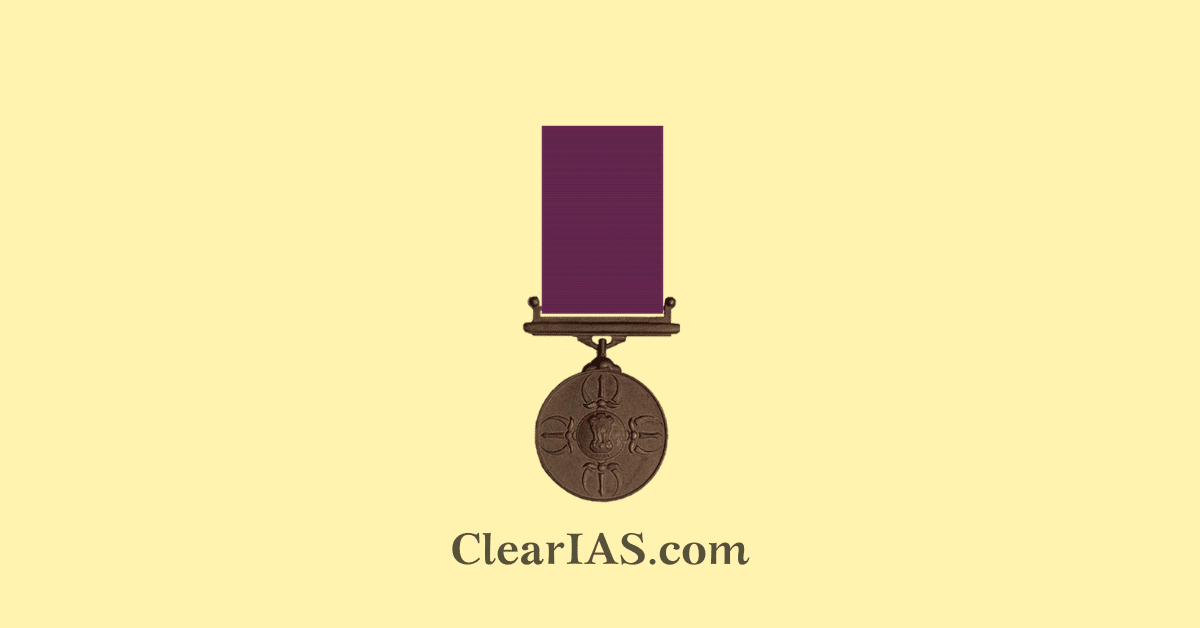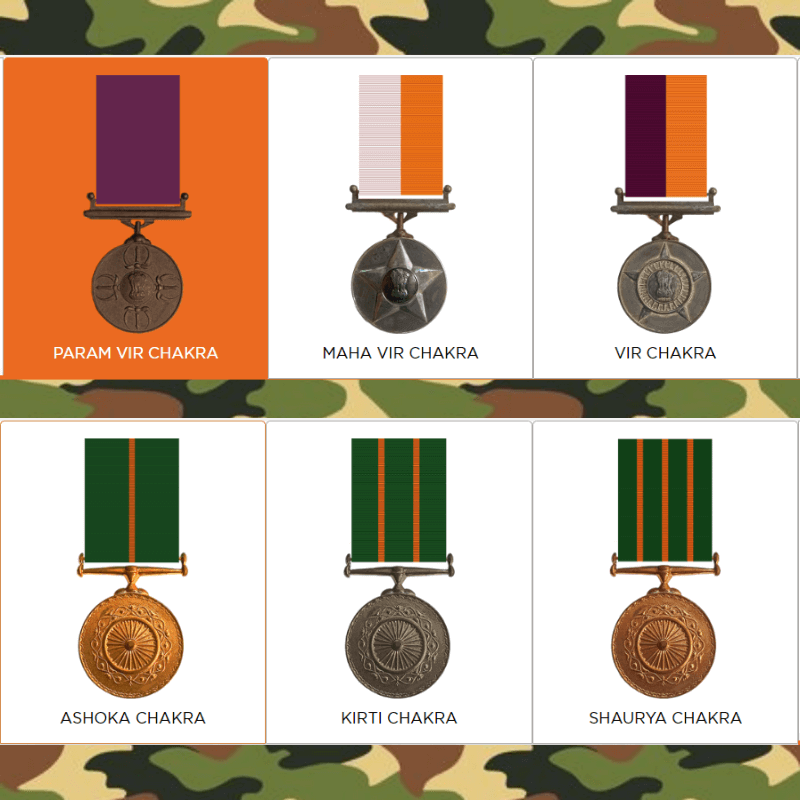
Gallantry Awards in India are prestigious honors bestowed upon personnel of the Indian armed forces and occasionally civilians, recognizing their bravery, valor, and sacrifice. Read here to learn more.
These awards are given for displaying conspicuous gallantry, indomitable courage, and extreme devotion to duty.
The President of India confers these awards in the name of the Republic of India.
Gallantry Awards in India
Post-independence, the first three gallantry awards namely Param Vir Chakra, Maha Vir Chakra, and Vir Chakra were instituted by the Government of India on 26th January 1950 and were deemed to have effect from the 15th August 1947.
Thereafter, other three gallantry awards i.e. Ashoka Chakra Class-I, Ashoka Chakra Class-II, and Ashoka Chakra Class-III were instituted by the Government of India on 4th January 1952, which were deemed to have effect from the 15th August 1947.
- These awards were renamed as Ashoka Chakra, Kirti Chakra, and Shaurya Chakra respectively in January 1967.
These gallantry awards are announced twice a year – first on the occasion of Republic Day and then on the occasion of Independence Day.
The order of precedence of these awards is the Param Vir Chakra, the Ashoka Chakra, the Mahavir Chakra, the Kirti Chakra, the Vir Chakra, and the Shaurya Chakra.
Param Vir Chakra
- Highest military decoration in India.
- Awarded for the most conspicuous bravery or some daring or pre-eminent act of courage or self-sacrifice, in the presence of the enemy, whether on land, at sea, or in the air.
- Established on 26th January 1950 (retrospectively from 15th August 1947).
- Medal: Circular in shape, made of bronze, one and three eighth inches in diameter, and shall have embossed on the obverse four replicas of “Indra’s Vajra” with the State Emblem embossed in the center. On its reverse, it shall have embossed “PARAM VIR CHAKRA” in Hindi and English with two lotus flowers between the Hindi and the English inscriptions.
- Ribbon: Plain purple colored ribbon.
- Bar: If any recipient of the Chakra again performs such an act of bravery, as makes him or her eligible to receive the Chakra, such further act of bravery shall be recorded by a Bar to be attached to the riband by which the Chakra is suspended. For every Bar awarded, a replica of the “Indra’s Vajra” in miniature shall be added to the riband when worn alone.
Mahavir Chakra
- Second highest military decoration in India.
- Awarded for acts of conspicuous gallantry in the presence of the enemy, whether on land, at sea, or in the air.
- It is the peacetime equivalent of the PVC.
- Medal: Circular in shape is made of standard silver, and is embossed on the obverse a five-pointed heraldic star with the points of the star just touching the rim. The medal shall be one and three-eighth inches in diameter. The State emblem (including the motto) is embossed in the center-piece which is adorned. The star is polished and the centre piece is in gold gilt. On the reverse, it will have embossed Maha Vir Chakra both in Hindi and English with two lotus flowers between Hindi and English. The fitting is swivel mounting.
- Ribbon: The ribbon is of a half-white and half-orange color.
- Bar: If any recipient of the Chakra again performs such an act of bravery, as makes him or her eligible to receive the Chakra, such further act of bravery will be recorded by a Bar to be attached to the riband by which the chakra is suspended. For every Bar awarded, a replica of the Chakra in miniature shall be added to the riband when worn alone.
Vir Chakra
- Third in precedence among wartime gallantry awards.
- Awarded for acts of gallantry in the presence of the enemy, whether on land, at sea, or in the air.
- Medal: Circular in shape is made of standard silver, and is embossed on the obverse a five-pointed heraldic star with the points of the star just touching the rim. The State Emblem (including the motto) is embossed in the domed centerpiece. The star is polished and the centre piece is in gold gilt. On the reverse, it will have embossed Vir Chakra both in Hindi and English with two lotus flowers between Hindi and English wording. The fitting is swivel mounting.
- Ribbon: The ribbon is half blue and half orange in color.
- Bar: If any recipient of the Chakra again performs such an act of bravery, as makes him or her eligible to receive the Chakra, such further act of bravery will be recorded by a Bar to be attached to the riband by which the Chakra is suspended. Any such Bar or Bars may also be awarded posthumously. For every Bar awarded, a replica of the Chakra in miniature shall be added to the riband when worn alone.
Peacetime gallantry awards

Ashoka Chakra
- The highest peacetime gallantry award is equivalent to the PVC but awarded for valor, courageous action, or self-sacrifice away from the battlefield.
- It can be awarded to both military and civilians, including posthumous awards.
- Medal: Circular in shape, one and three-eighth inches in diameter with rims on both sides and will be of gold gilt. On the obverse, it shall have embossed a replica of Ashoka’s Chakra in the center surrounded by a lotus wreath. On its reverse shall be embossed the words “Ashoka Chakra” in Hindi and English, the two versions being separated by two lotus flowers.
- Ribbon: Green color ribbon divided into two equal segments by an orange vertical line.
- Bar: If a recipient of the Chakra again performs such an act of gallantry as would have made him or her eligible to receive the Chakra, such further act of gallantry shall be recognized by a Bar to be attached to the riband by which the Chakra is suspended and, for every subsequent act of gallantry, an additional Bar shall be added. For every such Bar, a replica of the Chakra in miniature shall be added to the riband when worn alone.
Kirti Chakra
- Second in order of precedence of peacetime gallantry awards.
- Awarded for conspicuous gallantry otherwise than in the face of the enemy.
- Medal: Circular in shape and made of standard silver, one and three eight inches in diameter. On the obverse of the medal shall be embossed a replica of Ashoka Chakra in the center, surrounded by a lotus wreath. On its reverse shall be embossed the words KIRTI CHAKRA both in Hindi and in English the versions being separated by two lotus flowers.
- Ribbon: Green color ribbon divided into three equal parts by two orange vertical lines.
- Bar: If a recipient of the Chakra again performs such an act of gallantry as would have made him or her eligible to receive the Chakra, such further act of bravery shall be recognized by a Bar to be attached to the riband by which the Chakra is suspended. For every Bar awarded, a replica of the Chakra in miniature shall be added to the riband when worn alone.
Shaurya Chakra
- Third in order of precedence of peacetime gallantry awards.
- Awarded for gallantry otherwise than in the face of the enemy.
- Medal: Circular in shape and of bronze, one and three-eighth inches in diameter. On the obverse of the medal shall have embossed a replica of Ashoka Chakra in the center, surrounded by a lotus wreath. On its reverse shall be embossed the words “SHAURYA CHAKRA” both in Hindi and English, the two versions being separated by two lotus flowers.
- Ribbon: Green color ribbon divided into four equal parts by three vertical lines.
- Bar: If any recipient of the Chakra again performs such an act of gallantry as makes him or her eligible to receive the Chakra, such further act of gallantry will be recorded by a Bar to be attached to the riband by which the Chakra is suspended. For every Bar awarded, a replica of the Chakra in miniature shall be added to the riband when worn alone.
Other Gallantry Awards
- Sena Medal, Nao Sena Medal, and Vayusena Medal: Awarded to members of the Indian army, navy, and air force respectively for devotion to duty or courage as part of military operations.
- Sarvottam Yudh Seva Medal: Medal and Ribbon Instituted in 1980 to recognize the distinguished service of the most exceptional order during war/conflict/hostilities.
- Uttam Yudh Seva Medal: Medal and Ribbon Instituted in 1980 to recognize the distinguished service of an exceptional order during war/conflict/hostilities.
- Yuddh Seva Medal: Medal and Ribbon Instituted in 1980 to recognize distinguished service of a high order during war/conflict/hostilities.
- Param Vishisht Seva Medal: Medal and Ribbon Instituted in 1960 as VSM Class-I to recognize the distinguished service of the most exceptional order.
- Ati Vishisht Seva Medal: Medal and Ribbon Instituted in 1960 as VSM Class-II for distinguished Service of an exceptional order.
- Vishisht Seva Medal: Medal and Ribbon Instituted in 1960 and as VSM Class-III to recognize the distinguished service of a high order.
- Mention in Dispatches: Recognizes distinguished and meritorious service in operational areas and combat zones that are not of a sufficiently high order to warrant the grant of gallantry awards.
Eligibility and Procedure
The Ministry of Defence invites recommendations twice in a year from the Armed Forces and Union Ministry of Home Affairs for gallantry awards.
- Personnel from all branches of the Indian armed forces, paramilitary forces, and civilians are eligible for these awards.
- The awards are typically announced biannually – on Republic Day (26th January) and Independence Day (15th August).
- The selection process involves recommendations from the chain of command, with final approval by the Awards Committee, headed by the Defence Minister and ratified by the President of India.
Significance of Gallantry Awards
- Gallantry Awards are a recognition of the extraordinary bravery and selflessness exhibited by the awardees.
- They serve to inspire and motivate the armed forces and civilians alike.
- These awards also acknowledge the sacrifices made by the armed forces in protecting the sovereignty and integrity of the country.
The Gallantry Awards hold a place of great honor and respect in India, symbolizing the highest standards of courage and heroism in challenging situations.
Related articles:
-Article by Swathi Satish





Leave a Reply